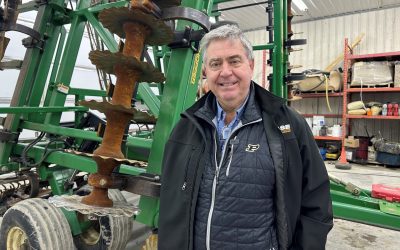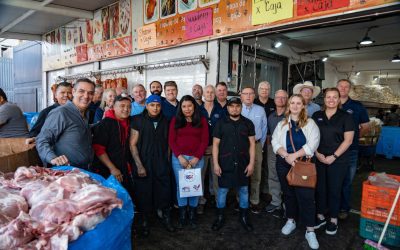Three ways WISHH builds soybean demand and drives growth
Posted: October 31, 2022
Category:
Indiana Corn and Soybean Post - Fall 2021, ISA
West African food and feed company CEO Samuel Ntim-Adu praises his 2016 and 2018 trips to Indiana with ASA’s World Initiative for Soy in Human Health (WISHH). Time spent with Indiana soybean growers and at Purdue University strengthened his commitment and technical knowledge to expand his use of soy in human foods as well as start manufacturing poultry and other livestock feeds.
Working with entrepreneurs, such as Ntim-Adu in Ghana, is one of the three top ways WISHH leads market systems approaches for Indiana soy protein in some of the fastest growing countries in the world. Association development and aquaculture are also top-tier strategies for WISHH, which is working in 22 developing or emerging markets in Asia, Africa and Latin America where there is growing protein demand.
Visionary soybean growers, including those from Indiana, helped establish WISHH more than 20 years ago when they saw the need for U.S. soybean growers to launch a trade catalyst and food security leader. WISHH cultivates progress with private-sector entrepreneurs as well as government and non-governmental organizations in developing markets often located more than 5,000 miles from the fertile Indiana soybean fields.

“From aquaculture in Africa to soy-fortified beverages in Central America, WISHH is trailblazing new opportunities for Indiana soy demand,” said Oaktown, Ind., soybean grower Craig Williams, who serves as an Indiana Soybean Alliance (ISA) director as well as on the WISHH Program Committee. “WISHH has to start from scratch in countries. It is far more complicated than just finding a buyer for U.S. soy. WISHH has to do everything from in-country market assessments to education on the importance of protein in human and animal diets to how to mix proper feed rations with soybeans.”
In 2020 and 2021, WISHH had to pivot to virtual trainings and other technical assistance. Yet, progress has continued. Ntim-Adu’s Yedent Agro Group’s accomplishments are notable in any year. Achieving such resilient results in the midst of a pandemic is exceptional.
For example, two of Yedent’s soy-based fortified foods are newly approved to bear the Obaasima logo seal, a Bill and Melinda Gates Foundation-supported program to differentiate nutritious foods in Ghana.
Obaasima is the first front-of-pack seal for fortified foods in the country and is tailored to promote good nutrition for women and children. The Association of Ghana Industries leads the logo initiative that verifies the product and advertising meet the high standards of Ghana’s Food and Drug Administration. Yedent’s soy-based Tom Vita Regular and Tom Vita X both earned the seal in April, recognizing that they contain 18 vitamins and minerals.
“The entry standards are high to meet Obaasima’s specifications, but we are prepared to fill the market with nutritious foods,” said Ntim-Adu who has launched an extensive brand campaign on radio, television, social media and in markets.
Yedent uses U.S.-made soy extrusion equipment to manufacture both 18 percent protein products. Tom Vita is an instant cereal legume mix. Tom Vita X is a ready-to-eat cereal legume mix.
Soy added to food for millions of Africans
WISHH’s entrepreneurial collaboration with companies like Yedent is also an opportunity to add soy protein to a popular cassava-based food. Cassava is a staple or subsidiary food for about one-fifth of the world’s population, according to the African Journal of Food, Agriculture, Nutrition and Development.
Cassava grows widely in West Africa and is used to make gari, a staple in the diet of millions of Ghanaians and Nigerians. Cassava offers carbohydrates but makes gari low in protein. WISHH is working with scientists and companies that can make soy part of the solution for improved health. Scientific African Journal has published peer-reviewed research led by a scientist who works closely with WISHH. Ghanaian Research Scientist Leticia Amoakoah Twum, a 2014 Borlaug Fellow at Purdue University, is investigating the commercial possibility of using soy flour in a West African staple food, gari. Food researchers believe Amoakoah Twum’s work has huge potential to reduce iron deficiency anemia and protein-energy malnutrition among gari consumers in Africa.
She and her colleagues at the Biotechnology and Nuclear Agricultural Research Institute (BNARI) found that an iron fortified, soy flour-gari blend not only produces a greater yield for consumption, but it also provides an increased nutritional value that traditional gari lacks. Consumers also like the slightly nutty taste of the soy flour gari.

Amoakoah Twum praises her three months at Purdue where she received valuable food technology training at Purdue’s Food Science Department under the guidance of Srinivas Janaswamy, Ph.D., then a professor at the university.

Her Borlaug Fellowship at Purdue laid a valuable foundation for her soy-gari research. She is especially proud of the study, because she describes it as her way of continuing the legacy of Norman E. Borlaug, who is called the Father of the Green Revolution. Amoakoah Twum’s Fellowship included visits to U.S. soybean farms as well as participation in the World Food Prize International Dialogue.
She said, “That year, the Dialogue emphasized the power of intensifying, innovating and inspiring to uplift smallholder farmers and meeting the increasing demand for nutritious food.”
Upon her return to Ghana, she participated in a briefing with the USDA Foreign Agricultural Service Counselor. He told her about WISHH’s soy-based gari work in Liberia through U.S. Agency for International Development funding.
To support the research in Ghana, WISHH Africa Regional Director delivered U.S. soy flour to the BNARI team in April 2016. WISHH continues working with the researcher and Yedent on a commercialization strategy for the gari in Ghana as well as exploring entrepreneurial opportunities for it in Nigeria.

In Kenya as well as Asia and Latin America, WISHH is providing virtual training by two Purdue faculty members, Joan R. Fulton and Maria I. Marshall, through WISHH’s United Soybean Board-funded Mobilizing Entrepreneurs to Expand U.S. Soy Utilization in Developing and Emerging Markets Initiative. Instruction by Marshall and Fulton is valuable for WISHH’s work to compress the time for a new U.S. soybean product to go from emerging market entry to basic market ready. More than 50 employees are participating ranging from CEOS to marketing as well as research and development teams.
Aquaculture grows 527 percent
Aquaculture is one of the big trends that WISHH’s strategies cultivate in Africa as well as Asia. The U.N.’s Food and Agriculture Organization (FAO) found a 527 percent increase in global aquaculture production from 1990 to 2018. The FAO “State of the World’s Fisheries and Aquaculture” (SOFIA) report states fish provided about 3.3 billion people with almost 20 percent of their average per capita intake of animal protein. In 2017, fish accounted for about 17 percent of total animal protein, and 7 percent of all proteins, consumed globally.
The report says further developing aquaculture in Africa and in other regions where population growth will challenge food systems the most should be a priority. WISHH is ahead of this trend.
In 2020, WISHH worked on aquaculture in eight African countries, reaching two new countries and laying the foundation for more in 2021. Despite COVID-19 challenges, WISHH made progress on its strategy to improve local fish feed production and processing in Africa by having 15 strategic partners from Nigeria, Ghana, Tanzania and Togo trained virtually on improved feed production.
WISHH used funding from USDA’s Foreign Market Development and Agricultural Trade Promotion Programs for the training.
In Cambodia, WISHH leads a USDA-funded project, Commercialization of Aquaculture for Sustainable Trade (CAST) – Cambodia. The project is designed to accelerate production of high-demand fish species for the Cambodian market and develop a lasting aquaculture industry. CAST strengthens local production of high-quality feed and fish. Through CAST, Cambodia’s private sector and universities work closely with U.S. soybean growers and businesses, as well as academic and non-governmental organizations.
WISHH launches ag associations abroad
WISHH goes global with the association leadership that took root in Indiana more than 100 years ago. In Cambodia, WISHH’s long-term strategy features the establishment and development of an aquaculture association. Launched in September 2020, the Cambodian Aquaculturist Association (CAA)’s membership ranks swelled to nearly 400 fish farmers and sellers, feed manufacturers and others in its first six months.

Cambodia’s Minister of Agriculture, Forestry and Fisheries has participated in multiple CAA activities and has stressed CAA’s importance to the Ministry’s initiatives to grow the quantity and quality of Cambodia’s aquaculture industry’s production.
Similarly in Ghana, WISHH partnered with private and public-sector leaders to launch an Egg Secretariat to carry on egg nutrition education while supply chain partners are helping fill the demand for improved poultry feeds made from quality grains.
The poultry industry in much of sub-Saharan Africa is restricted in its ability to grow due to high feed costs, and poor farm management practices. WISHH’s USDA funded project found that the country of Ghana’s national yearly per capita consumption increased to 235 in 2020. As a comparison, U.S. annual per-person consumption of eggs and egg products was 293 in 2019, according to USDA.
Such growing protein demand creates a host of opportunities for WISHH and Indiana soybean growers to ensure that U.S. soy plays a role in delivering improved nutrition to people throughout the world.
[/et_pb_text][et_pb_text admin_label=”Category Tags” _builder_version=”4.18.0″ _dynamic_attributes=”content” _module_preset=”default” locked=”off” global_colors_info=”{}”]@ET-DC@eyJkeW5hbWljIjp0cnVlLCJjb250ZW50IjoicG9zdF9jYXRlZ29yaWVzIiwic2V0dGluZ3MiOnsiYmVmb3JlIjoiQ2F0ZWdvcmllczogIiwiYWZ0ZXIiOiIiLCJsaW5rX3RvX3Rlcm1fcGFnZSI6Im9uIiwic2VwYXJhdG9yIjoiIHwgIiwiY2F0ZWdvcnlfdHlwZSI6ImNhdGVnb3J5In19@[/et_pb_text][/et_pb_column][/et_pb_row][/et_pb_section]



